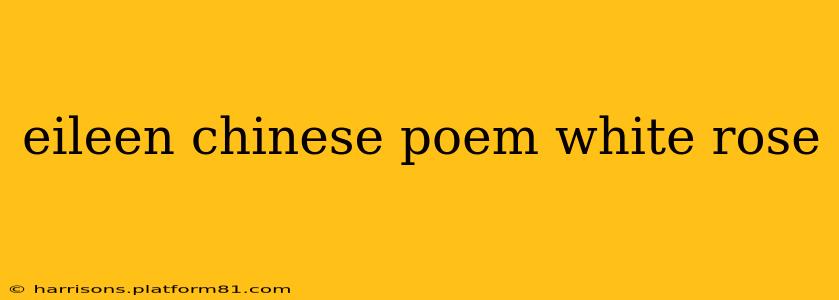Eileen Chang, a renowned Chinese author, didn't write a poem specifically titled "White Rose." However, the imagery of the white rose frequently appears in her works, particularly in her prose, often symbolizing purity, innocence, and sometimes, a bittersweet, unattainable love. This exploration delves into how the white rose functions symbolically in her writings and resonates with broader themes in her oeuvre.
What is the Significance of the White Rose in Eileen Chang's Works?
The white rose, in Chang's writing, rarely stands alone. It's usually intertwined with the complexities of human relationships, particularly the fraught dynamics between men and women in a rapidly changing China. The flower acts as a powerful visual metaphor, contrasting the delicate beauty of the rose with the often harsh realities of love, ambition, and societal pressures. It's a symbol that reflects both the idealized and the ultimately flawed nature of romantic ideals. Unlike a more vibrant red rose that might signify passionate love, the white rose in Chang's context carries a more nuanced meaning – one that suggests fragility, perhaps even a hint of melancholy.
Does Eileen Chang Have a Poem About White Roses?
No, there isn't a known poem by Eileen Chang specifically titled "White Rose." Her genius lay predominantly in her novels and short stories, where she masterfully used evocative imagery, including the white rose, to convey profound emotional depth. Her prose is highly poetic in its own right, brimming with lyrical descriptions and poignant observations of human nature.
What Other Symbols Does Eileen Chang Use?
Beyond the white rose, Eileen Chang’s writing is rich with symbolic imagery. She frequently uses clothing, particularly traditional Chinese garments, to highlight social status and the constraints placed upon women. Food and the act of eating also play significant roles, often reflecting the characters' emotional states and their relationships with each other. Mirrors often represent self-perception and the deceptive nature of appearances. These symbols, alongside the white rose, contribute to the complex and layered narratives that characterize her work.
What are the Main Themes in Eileen Chang's Writings?
The recurring themes in Eileen Chang's writings include:
- The complexities of love and relationships: Chang's works are renowned for their unflinching portrayal of romantic entanglements, exploring the power dynamics, betrayals, and disappointments inherent in love.
- The changing landscape of China: Her narratives often reflect the societal upheavals and transformations experienced in China during the early to mid-20th century.
- The struggles of women in a patriarchal society: Chang poignantly depicts the limitations and challenges faced by women within a traditional and often oppressive social structure.
- The search for identity and belonging: Her characters often grapple with questions of self-discovery and their place in a society undergoing rapid change.
Where Can I Find More Information About Eileen Chang?
Numerous academic resources, biographies, and critical analyses of Eileen Chang’s work are available. Exploring these resources will provide a deeper understanding of her artistry and the significance of symbols like the white rose within the context of her larger body of work. Searching for "Eileen Chang critical essays" or "Eileen Chang bibliography" will yield ample results for further research.
This exploration aims to provide a comprehensive understanding of Eileen Chang's use of imagery, particularly the white rose, while acknowledging the absence of a dedicated poem with that title. It highlights the symbolic depth within her prose and encourages further research into this influential Chinese author.
